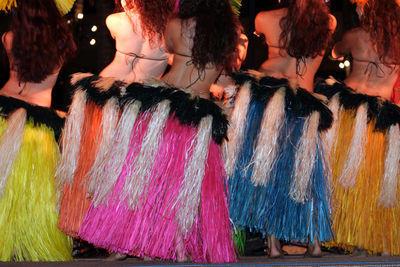The Hawaiian language is not a written one and it has been through chants and storytelling that the history and various aspects of its culture have been handed down to newer generations over the course of years. The same is true of the hula dancing which also told the stories of the lore and traditions within the Hawaiian community. The dances were fluid and flowing and took their simplicity from their natural surrounding such as the breezes and the movement of the waves and the flowing of the streams. Typically women would do the dancing and men would sing the chants and apply the beat of various percussion instruments.
It is believed that in the days prior to the arrival of the missionaries the hula skirt was made of leaves and was very short and the dancer was generally topless. This was of course considered much too vulgar for the sensibilities of the missionaries and they used their influence to force the hula dancers thereafter to wear longer skirts and to cover up their tops. That period of change which happened in the 1820’s and after in many ways severed the traditional importance of the hula as a means of communication and of the passing on of the Hawaiian culture. Many of the pieces of the Hawaiian societies of old have been replicated through studies of what was known of the past but much of it has simply been passed over or missed as a result of the break in the traditional handing down of information via word of mouth, chants and hula dancing.
When I first arrived to live in Hawaii in 1973 the long and continuous eruption of Kilauea had anothrer 10 years before it would begin its eruption in earnest and during that time I don’t ever remember having become aware of the term VOG. The word was invented to represent the conditions that occurred when sulfur dioxide which was emitted by the volcano was brought in contact with the Oxygen in the atmosphere as well as moisture and sunlight. The resultant material is referred to as VOG and it can prove every bit as devastating to the health of humans and other life forms as can smog as it might be found in Los Angeles, Beijing on Delhi.
It was in 1983 that a much much more vigorous level of eruptions began to occur on the Big Island and VOG then became a constant component of Hawaii’s weather system. Because the Big Island is located in the far south west corner of the state and because the general wind pattern effecting the islands is the north east trades on most days the volcano particulate tends to travel from its origin at Kilauea and below across the southern part of the island passing over Kailua-Kona and then blowing out to sea. On the more rare days when the wind blows from the south or does not blow at all the VOG will move to cover the other islands in the chain and in deed the VOG footprint can be seen expending way beyond the furthest major Hawaiian Island in the group, Kauai.
There are alerts forecast over the news if VOG is going to be frightfully bad on certain days and even when just seen on a much lower level the effects of the VOG can be seen in issues regarding respiration, itchy eyes and reactions to asthma.
Luckily most days in Hawaii are VOG free and we hope it continues that way but the world effects it own client when and how it chooses to. In 1883 the world was caught off guard by Krakatoa and the aftermath of that event caused the worlds temperature to drop for a year by 2.2 degrees Fahrenheit and the more recent Pinatubo eruption in 1990 in the Philippines cause the words sunlight reaching its surface to diminish about 10%.

